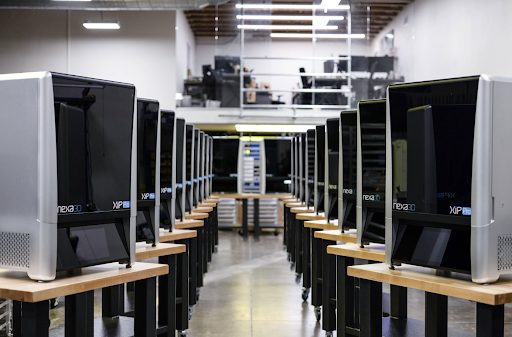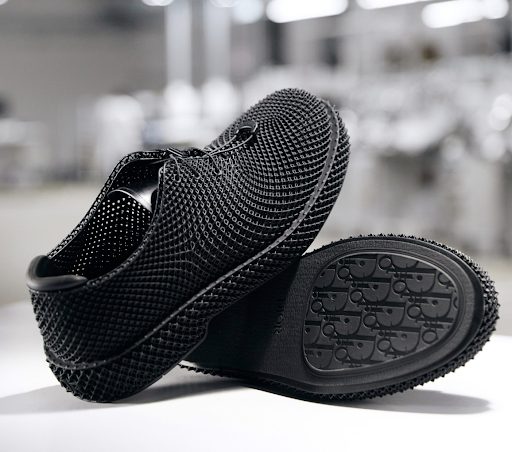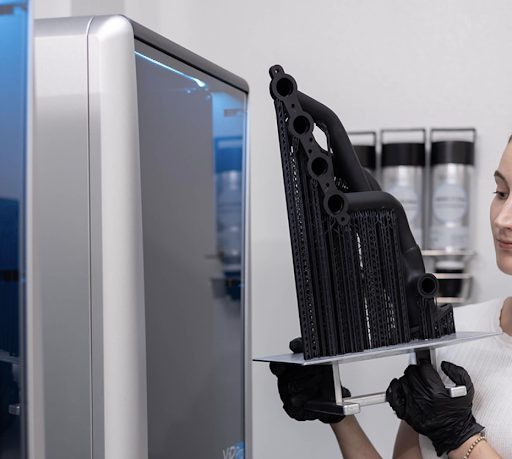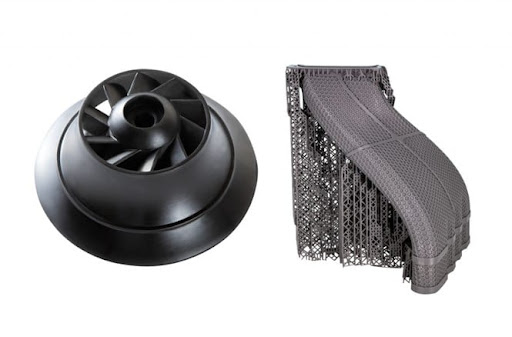- Markforged Onyx Filament Review & Alternatives [2024] - December 11, 2024
- 17 Best Professional 3D Printers: Commercial, Desktop, & Industrial [2024] - December 10, 2024
- Best 3D Printers (Industrial, Desktop, & More) [2024 Guide] - July 20, 2024
3D printing is an ever-evolving technology that is quickly revolutionizing both the industrial and commercial worlds. Healthcare professionals are using 3D printing for prosthetics, dental implants, and even the creation of organ tissue, while the aerospace industry leverages it to manufacture lightweight parts with complex geometries. Automobile manufacturers deploy the technology to rapidly prototype designs, and architects use it to create detailed scale models of structures. Even the world of fashion is impacted: 3D printing is being used to craft intricate jewelry and avant-garde clothing.
But beyond these exciting use cases of 3D printing, what does the actual landscape look like? What kind of growth has the industry seen? Which trends are emerging as we move through 2023? The answers to these questions reveal a fascinating narrative of technological advancement, adoption, and industry impact.
This post will dive into a compilation of some of the most significant 3D printing statistics and trends of 2023 to provide a panoramic view of the current state and future prospects of this innovative technology. Whether you’re an industry professional, an investor, or simply a 3D printing enthusiast, you’ll find a wealth of insights that reveal how 3D printing is shaping the world as we know it.
Exciting 3D Printing Statistics to Know

1. Global 3D printing to grow 2.8x by 2028
The 3D printing market is expected to reach a value of $56.21 billion in 2028, up from $20.24 billion in 2023. This projected growth indicates the expanding adoption of 3D printing across various industries, driven by advancements in technology and cost-effectiveness.
2. The 3D printing industry makes over 75% of total revenue from industrial printers
Out of the various printer types available, industrial 3D printers dominate the global revenue, constituting over 76% of the market share. Desktop 3D printers make up the remaining portion of the market.
While previously considered a best fit for hobbyists and small businesses, today’s desktop 3D printers have industrial-quality construction and high-end printing capabilities. Professional users invest in desktop 3D printers because they’re portable (compared to the footprint of the factory-sized 3D printers), durable, and more affordable.
3. Prototyping leads in 3D printing applications
The main 3D printing application among a thousand respondents is prototyping, as reported by 66% of the participants. Prototyping involves the creation of initial models or functional prototypes that serve as a visual representation of the final product. This enables them to test and validate their designs before moving into full-scale production
Additionally, 21% of respondents stated that their primary use of 3D printing is for producing end-use parts.
4. How many 3D printers have been sold?
Shipments of 3D printers are measured at around 2.2 million units in 2021 and are projected to reach 21.5 million units by the year 2030. The growth of the market will be driven by research and development activities in sectors like healthcare and aerospace, which will contribute to the expansion of the market over the next decade.
5. Polymer & plastic are some of the most popular 3D printing materials
Plastics and polymers are among the most widely used 3D printing materials. However, the versatility of 3D printing extends beyond these materials. 3D printing has opened new possibilities for using diverse materials to fabricate objects, ranging from intricate metal parts and composites to bio-printed human tissues.
6. Selective Laser Sintering (SLS) beats other processes in usage
The Selective Laser Sintering (SLS) market is projected to grow significantly, with an expected increase from $3.2 billion in 2023 to $8.8 billion by 2028, at a compound annual growth rate of 22.46%. This growth is driven by the rising demand for SLS 3D printers in developed countries, where research and development facilities are present.
SLS is widely used in the aerospace, automotive, and medical industries to produce parts that require tight tolerances or intricate details such as dental aligners, hearing aids, orthotics, and prosthetics.

SmartDrone maintains agile production processes with Nexa3D’s SLS 3D printers.
7. Polymer vs metal
The forecast for polymer 3D printer growth in 2023 and beyond is estimated to be around 13%. Suppliers expect a 20% growth in machine sales, whereas users anticipate a growth rate of around 10%. For metal printers, both suppliers and users agree on a growth projection of approximately 26% for the next five years.
8. Top brands use 3D printing technology to create custom apparel

To stay ahead of the curve, brands like Nike, New Balance, Adidas, Dior, Rebook, and Fendi have all explored 3D printing for creating components like midsoles, outsoles, and even entire shoe designs. 3D printing offers the potential for lightweight, supportive, and uniquely tailored footwear for athletes and general consumers.
9. 3D printing software and services to triple market growth
The markets for on-demand parts services and computer-aided design (CAD) software are expected to nearly triple in size.
10. 3D printed medical materials to gain more market share
The 3D printed prosthetics, orthotics, and audiology market is projected to generate $509 million in revenue by 2026. Furthermore, this market is expected to witness significant growth and reach $996 million by 2030.
11. What manufacturing method do people use more?
Despite metal additive manufacturing experiencing rapid growth, polymer 3D printing generates more than twice the revenue. Fused Deposition Modeling (FDM) remains the popular choice among respondents, with 56% reporting it as their most frequently used additive manufacturing method.
SLA 3D printing comes next, which is no surprise. SLA 3D printing is a resin 3D printing technique that produces objects by selectively curing photopolymer liquid resin through light-activated polymerization. Thanks to its ability to produce highly detailed and complex parts with repeatable accuracy and smooth surface finishes, this technology is quickly becoming a favorite for medical devices, engineering and product design, complex manufacturing parts, and much more.

Made with Nexa3D’s resin 3D printer the XiP Pro.
3D Printing Market Trends to Look For
We’ve seen some statistics on the increasing adoption of 3D printing across various industries, such as automotive, aerospace, healthcare, and consumer products. Now, let’s peek into the future and see how this technology is going to further disrupt manufacturing.
1. Sustainability is gaining ground each year
Sustainability in 3D printing is expected to become a more prominent trend in 2023 and beyond. 3D printing technology helps achieve sustainability goals by reducing overproduction, eliminating product waste, minimizing transportation efforts, and using lighter and stronger designs. Recyclable and bio-derived materials are also gaining prominence.
Meeting end customer demands for sustainable products and repairability further drives the adoption of additive manufacturing.
2. 3D printing is changing the face of car manufacturing

As the automotive industry shifts towards electric vehicles, 3D printing is playing a crucial role. By leveraging 3D printing’s capabilities, automakers can design and produce car parts faster and more efficiently. Additive manufacturing enables them to meet ambitious production targets and gain a competitive edge.
3. 3D printed parts will have codes embedded on them in the future
Organizations in the 3D printing industry are exploring coding digital information into the surface texture of 3D printed parts. This advancement allows for enhanced tracking and identification. By embedding information into the texture, it becomes readable by both humans and machines.
This trend is expected to revolutionize operations, inventory management, and tracking systems as businesses look for more efficient ways to monitor their products.
4. The 3D printing industry is facing job shortages
It’s projected that the manufacturing workforce shortage could increase by over 2.5 times the current deficit by 2030. In the case of AM, this would result in over 20,500 unfilled jobs in the US. Across the entire manufacturing industry, this shortage could reach over 2.1 million job vacancies.
5. The medical field is advancing to 4D printing
4D printing, an advancement in 3D printing, has gained attention in the medical field. 4D printing is an advanced form of 3D printing that involves creating objects that can self-transform or self-assemble over time. It utilizes special materials that can change their shape, properties, or functionality in response to external stimuli.
This technology has the potential to revolutionize various areas such as drug research, biosensor development, and optics. Experts predict that 4D printing could contribute to the advancement of therapies for rare diseases and the creation of biomedical implants that can adapt to the specific microenvironment surrounding an organ.
6. Metal 3D printing to be utilized for more end-use parts production
According to experts, more industrial markets in the aerospace and energy sectors are adopting metal 3D printing for the production of end-use parts. This trend is expected to continue and be further supported by the growing use of composite materials in production applications.
Looking ahead, there is an anticipation of new printing solutions specifically designed for mass production, allowing manufacturers to accelerate their workflows in previously unimaginable ways.
7. More materials to be compatible with 3D printers
Materials already established in injection molding and other processes will also become more viable for 3D printing. In the future, materials designed specifically for 3D printing might find applications in traditional manufacturing methods as well. Furthermore, the selection of recycled materials and biomass-based materials will continue to grow and diversify.
Download our latest 3D printing material guide for an even deeper review of the most popular 3D printing materials in 2023.

8. There’s much more 3D printing to come.
More than 60% of 3D printer users express their intention to increase their investment in this technology and another 36% expressed their desire to maintain their current level of investment, for a total of 96% of manufacturers interested in continuing their 3D printing journey.
Join the Future with 3D Printing
As we conclude this deep dive into the world of 3D printing statistics and trends, it’s evident that this groundbreaking technology is far more than a passing fad. The data points we’ve explored indicate a technology on the rise, poised to reshape many aspects of our lives. It’s not just about creating–but about innovating, revolutionizing, and driving sustainable development across various industries.
But what does the future hold? Based on current trends, we can expect to see 3D printing play an even larger role in areas like personalized medicine, sustainable manufacturing, and even in the exploration of space. The technology is set to become more accessible, faster, and more efficient, taking us closer to a future where 3D printed products are commonplace.
Our Nexa3D printers take this vision seriously. Offering unprecedented speed, precision, and scalability, Nexa3D is your gateway to harnessing the full potential of additive manufacturing.
Whether you’re looking to prototype innovative products or produce high-performance industrial parts, Nexa3D empowers you to turn your vision into reality. As we continue to chart the course of 3D printing into unexplored territories, Nexa3D is equipped to lead the way, delivering unparalleled quality and functionality to users worldwide.
Let Nexa3D help you settle in comfortably in a 3D printed world.
